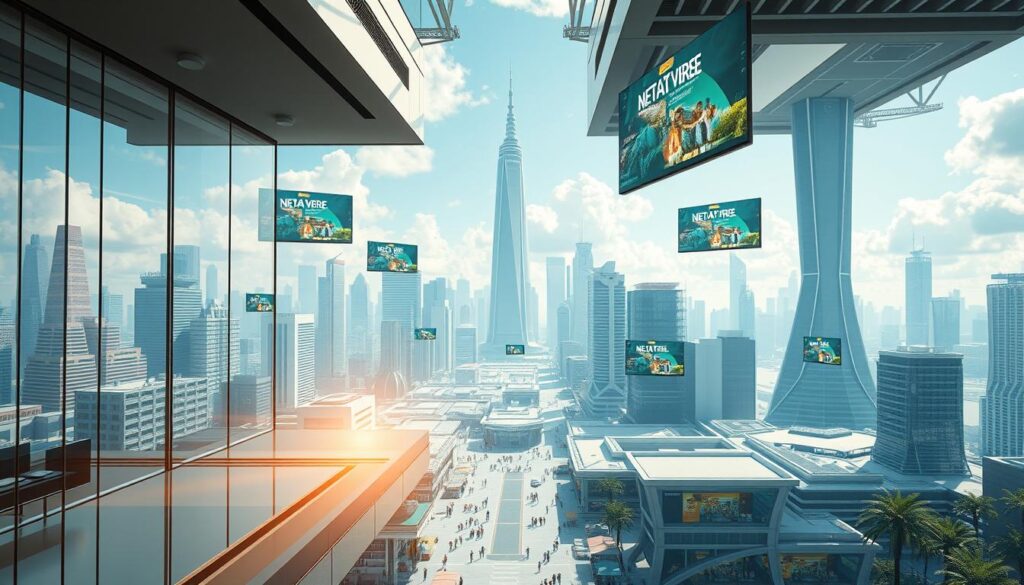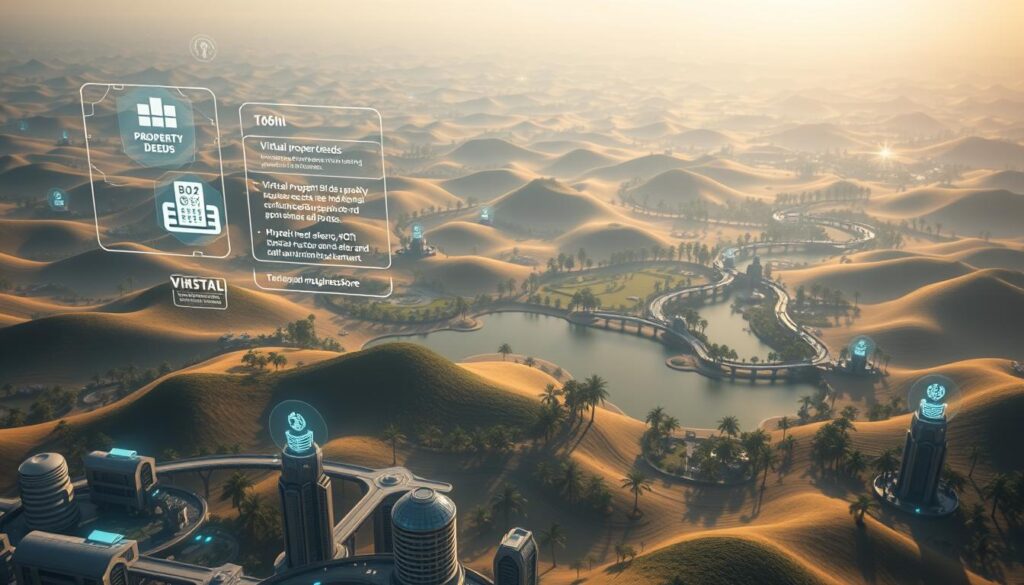Now Reading: Your Guide to Metaverse NFT Property Investment Opportunities
- 01
Your Guide to Metaverse NFT Property Investment Opportunities
Your Guide to Metaverse NFT Property Investment Opportunities

What began as a futuristic idea in 1992 has blossomed into interactive 3D environments where millions work, play, and trade. Analysts at Citi forecast these immersive platforms could grow into a $13 trillion ecosystem by 2030, with early adopters already securing stakes in this frontier.
Digital land parcels now function like physical counterparts – bought, developed, and monetized through blockchain-secured ownership. The sector surged to $500 million in 2021, with industry leaders like Decentraland and The Sandbox hosting thriving marketplaces. Unlike traditional markets, these spaces offer 24/7 global access and lower financial barriers.
Platforms blend commerce with creativity, letting users build virtual stores, galleries, and entertainment hubs. Major brands from Sotheby’s to Samsung now operate in these realms, blurring lines between physical and digital economies. For those seeking guidance, this comprehensive breakdown details strategies for navigating this landscape.
Key Takeaways
- Interactive 3D environments could surpass $13 trillion in value within seven years
- Blockchain technology enables secure ownership of digital land parcels
- Entry costs often fall below traditional real estate requirements
- Leading platforms host diverse commercial and creative projects
- Corporate adoption validates the sector’s economic potential
Understanding the Metaverse Landscape and NFT Property Investment
Digital environments have evolved dramatically since the days of text-based multiplayer games. Today’s immersive spaces blend cutting-edge tech with economic systems, letting users own and develop virtual land. Blockchain-secured deeds and 3D creation tools now turn empty plots into valuable assets.
The Evolution from Virtual Worlds to Digital Real Estate
Early online spaces focused on social interaction and basic gameplay. Modern platforms integrate VR headsets, 3D modeling, and decentralized ledgers. This shift transformed pixels into tradable properties with provable ownership. Tools like Ethereum’s blockchain let buyers verify transactions instantly, creating trust in digital markets.

Key Platforms Shaping the Future
Decentraland uses MANA cryptocurrency for land deals, while The Sandbox offers game-making tools for custom experiences. Crypto Voxels emphasizes user-generated art galleries, and Somnium Space supports VR-compatible homes. Each platform operates its own economy, appealing to different creative and commercial goals.
These ecosystems vary in governance too. Some let users vote on platform changes, while others prioritize developer control. Understanding these differences helps investors align choices with long-term strategies.
Exploring the metaverse NFT property investment opportunities guide
Digital landscapes are redefining value creation through immersive ownership models. Early participants gain access to growth patterns mirroring tech startups’ explosive trajectories. A 2021 transaction saw blockchain-based land sell for $4.3 million, showcasing rapid appreciation possibilities absent in traditional markets.

Growth Advantages in Emerging Markets
Digital plots enable creative development without physical limitations. Owners design interactive stores, concert venues, or advertising hubs using intuitive 3D tools. Revenue streams multiply through leasing, event tickets, and branded partnerships.
| Feature | Digital Assets | Physical Assets |
|---|---|---|
| Entry Cost | $500 – $5,000 | $50,000+ |
| Development Rules | Unrestricted | Zoning Laws |
| Global Access | 24/7 | Location-Dependent |
Balancing Innovation With Caution
While digital spaces offer novel prospects, price swings remain significant. Platform stability and user adoption directly impact asset values. Regulatory frameworks continue evolving, creating uncertainty for long-term holders.
Diversification helps mitigate risks. Savvy participants spread holdings across multiple platforms and revenue models. Continuous market research becomes essential in this fast-changing sector.
Navigating Virtual Real Estate Market Trends
Market patterns in digital spaces echo early internet expansion, with valuations climbing faster than physical counterparts. The sector hit $500 million in 2021, with analysts forecasting billion-dollar milestones ahead. Strategic positioning now could mirror pioneering successes in e-commerce or social media.

Data-Driven Growth and Market Projections
Citi’s $13 trillion valuation forecast by 2030 highlights explosive potential. Monthly platform users increased 88% last year, driving demand for prime locations. High-traffic zones near virtual landmarks command premiums, much like Manhattan storefronts.
Three factors shape value:
- Developer activity in adjacent plots
- Platform-specific user retention rates
- VR hardware adoption curves
Comparing Virtual and Traditional Real Estate
| Factor | Digital Plots | Physical Lots |
|---|---|---|
| Transaction Speed | Minutes | Months |
| Maintenance Costs | $0 | 1-4% annually |
| Global Buyers | Unlimited | Localized |
While brick-and-mortar assets provide tangible utility, virtual spaces enable 24/7 revenue streams through events and advertising. Both require location analysis – whether studying foot traffic patterns or avatar movement heatmaps.
Step-by-Step Process for Investing in Virtual Land
Securing digital assets starts with mastering key technical steps. This guide simplifies the journey from wallet setup to confirmed ownership.
Setting Up Digital Wallets and Acquiring Cryptocurrency
Begin by choosing a secure wallet. MetaMask and Coinbase Wallet work with most platforms. Always enable two-factor authentication and store recovery phrases offline.

Platforms require specific coins for transactions. Decentraland uses MANA tokens, while The Sandbox operates with SAND. Ethereum (ETH) serves as a cross-platform currency for many purchases.
| Wallet | Security Features | Supported Coins |
|---|---|---|
| MetaMask | Seed phrase + password | ETH, MANA, SAND |
| Coinbase | Biometric login | 100+ currencies |
| Trust Wallet | Encrypted backups | ETH, SAND |
Transaction Processes and NFT Ownership
Marketplaces like OpenSea list available plots. Filter searches by price, location, and platform compatibility. Prime spots near virtual hubs often yield better returns.
Complete purchases directly through platform portals or third-party sites. Blockchain verification occurs instantly – check your wallet for the NFT deed. These digital certificates prove exclusive ownership rights.
Remember:
- Gas fees vary by network traffic
- Transactions can’t be reversed
- Store NFTs in cold wallets for maximum security
Successful investors track platform updates and community trends. Regular engagement helps spot emerging opportunities before they peak.
Choosing the Right Metaverse Platform for Your Investment
Investors must evaluate multiple factors when entering blockchain-based virtual spaces. Three elements determine success: technical capabilities, community strength, and alignment with personal goals. Let’s break down how to assess these components effectively.
Platform Features, Community, and User Insights
Start by comparing development tools and interface quality. Leading platforms offer drag-and-drop builders for 3D spaces, while others require coding skills. Mobile accessibility matters too – 43% of users access digital worlds through smartphones.
Examine governance models and update schedules. Active developer teams often signal platform stability. Check monthly user growth rates and average session durations through third-party analytics tools.
Strong communities drive value through events and collaborations. Look for platforms with active forums, creator incentives, and social features like voice chat. These elements foster engagement, directly impacting virtual land ownership strategies.
Decentraland, Sandbox, and Other Leading Options
Decentraland dominates with its established economy using MANA tokens. Its open marketplace supports diverse projects, from art galleries to casinos. The Sandbox attracts brands through partnerships – Atari and Warner Music Group host experiences there.
| Platform | Currency | Focus |
|---|---|---|
| Decentraland | MANA | Commerce & Social |
| The Sandbox | SAND | Gaming & Brands |
| Crypto Voxels | ETH | Art Communities |
| Somnium Space | CUBE | VR Immersion |
Emerging platforms like Somnium Space offer VR-focused worlds, while Crypto Voxels prioritizes grassroots creativity. Third-party markets like OpenSea enable cross-platform transactions, but verify compatibility before purchasing.
Creative Monetization Strategies in Virtual Worlds
Digital spaces unlock revenue streams through imaginative design and audience engagement. Owners transform blank plots into dynamic destinations using 3D tools and strategic planning. This approach turns empty land into thriving hubs for commerce and culture.
Developing, Leasing, and Building Experiences
Construct interactive venues that attract consistent traffic. Fashion brands like Gucci create pop-up boutiques, while gaming companies build immersive arenas. Lease options range from hourly event spaces to long-term storefront rentals.
Consider these development approaches:
- Art galleries with rotating exhibitions
- Co-working spaces for remote teams
- Educational centers offering virtual classes
Hosting Virtual Events and Innovative Commercial Models
Music festivals in Decentraland draw crowds of 10,000+ avatars. Conference organizers charge admission fees and secure sponsorships. Product launches leverage interactive demos to boost real-world sales.
| Event Type | Revenue Streams |
|---|---|
| Concerts | Tickets, merch sales |
| Trade Shows | Booth rentals, ads |
| Workshops | Registration fees |
Forward-thinking businesses partner with creators for branded experiences. Advertising billboards in high-traffic zones generate passive income. These strategies blend creativity with smart economics.
The Role of Blockchain Technology and NFT
Blockchain’s decentralized framework forms the backbone of trust in digital ownership. Its transparent ledger system ensures every transaction remains tamper-proof, giving buyers confidence in their purchases. This technology enables instant verification of deeds, eliminating paperwork delays common in traditional systems.
Digital certificates linked to blockchain ledgers redefine asset control. Owners can transfer rights globally in minutes, bypassing intermediaries. Platforms using these systems reduce fraud risks while expanding market participation to broader audiences.
Tokenization breaks barriers by splitting assets into affordable shares. A $100,000 plot becomes accessible through $100 fractions, inviting smaller investors. This approach aligns with trends in NFT real estate marketplace development, where flexibility drives growth.
Over 11 million users may engage with tokenized assets by 2026, per industry forecasts. The blend of 24/7 access and creative monetization reshapes economic models. As boundaries between tangible and virtual assets fade, blockchain’s role as an innovation catalyst grows clearer.












